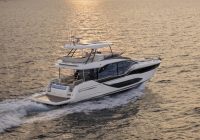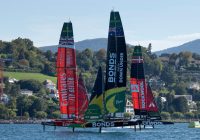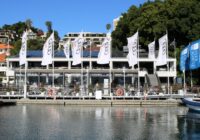France sealed its first ever event victory in Cádiz by sailing the shortest distance and performing the fewest amount of manoeuvres in comparison to competitors Australia and the United States.
Quentin Delapierre’s team sailed a total distance of 7,522m throughout the Final, 167m fewer than the U.S. and 541m fewer than Australia, according to SailGP Insights.

These gains took place predominantly on legs 3 and 5, during which the French team sailed a total distance of 3,768m, compared to the U.S.’s 4,131m and Australia’s 4,074m.
The French F50 also only performed seven manoeuvres – five tacks and two gybes – while both the Australian and American crews performed 10 apiece. Key to the French team’s success was their ability to remain foiling throughout manoeuvres, while both the Australians and Americans fell off the foils while turning, dramatically reducing their speed and slowing their progress.
France also had the best start out of the three boats. The French F50 was positioned 20.9m from the line and travelling at 33.7 km/h when the race began, while the U.S. was 32m from the start line and travelling at a speed of 31.5 km/h.
Aggressive tactics by the U.S. boat, which turned sharply in front of Australia in the run up to the start line, meant the Australians were positioned 51.1m away when the race began – the furthest of the three boats. However, Australia also had the highest starting speed and was travelling at 38.7 km/h.

There were two surprises in the data collected from the podium race, the first of which revealed that France had the lowest average speed of the three boats. The French travelled at an average speed of 35.5 km/h in comparison to the U.S.’s 36.1 km/h and Australia’s 36.3 km/h.
The U.S. also hit the highest speed out of the three boats – racking up a top speed of 54.4 km/h on the third leg upwind, while France recorded a top speed of 53.3 km/h on the second leg downwind and Australia hit 49.6 km/h on the same leg.

The second surprise was the foil stability of the three boats – the amount of time each boat was foiling throughout the race. With all three flight controllers jettisoned ahead of the race to allow for a four-person configuration, it was up to the drivers to fly the boats as well as steer.
Australia driver Tom Slingsby said afterwards that he struggled to juggle both roles, but SailGP Insights shows that Australia actually foiled for 72.5% of the race – the highest of all three boats. In comparison, France had a fly time of 69.6% and the U.S. foiled for 68.4% of the race.







